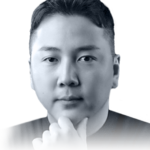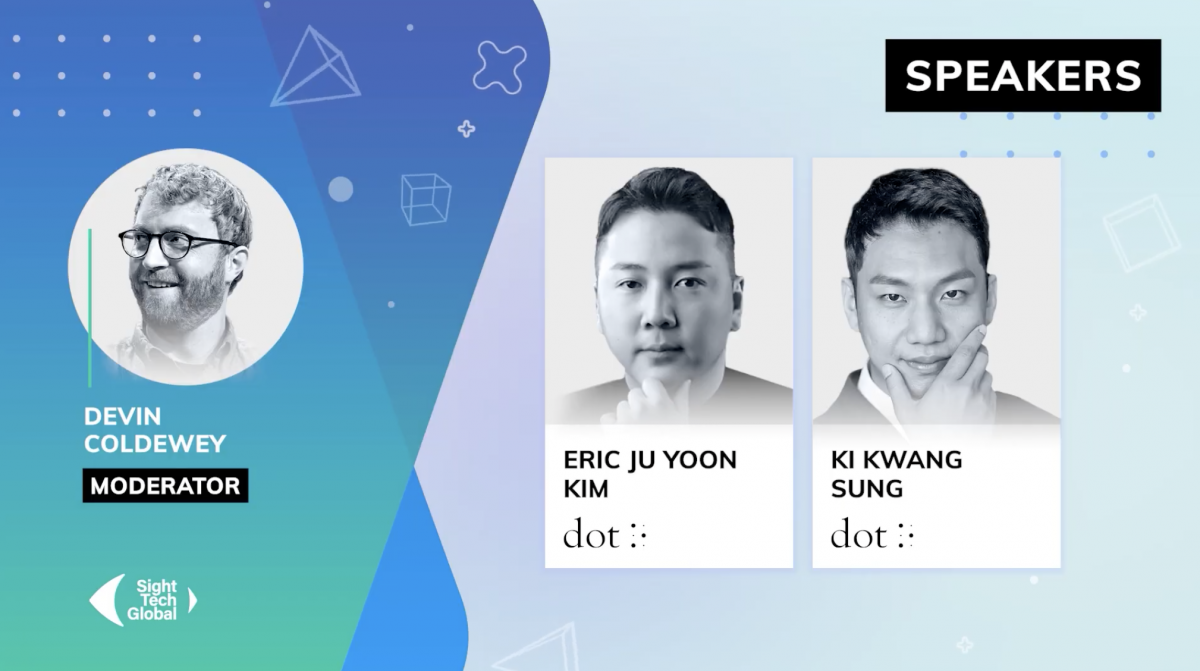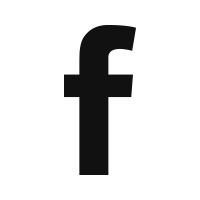PR/IR
News
News
- Date
- 2022.12.08 09:00
- DESCRIPTIONFor decades, engineers have worked toward a Braille display that can render tactile images and multi-line Braille. DOT Pad may have cracked the code with an innovative approach to generating dynamic fields of Braille pins combined actuated by smart integrations with existing technologies, like Apple's VoiceOver. Eric Kim and Ki Sung will also lead a breakout session for attendees to want to learn more.
Speakers

Ki Kwang Sung, Co-founder/CBDO, Dot Inc.

Eric Ju Yoon Kim, Co-founder/CEO, Dot Inc.

Moderator: Devin Coldewey, Writer & Photographer, TechCrunch
- SESSION TRANSCRIPT
[MUSIC PLAYING]
BRIAN: The Dot Pad: How the Bible Inspired a Breakthrough. Moderator, Devin Coldewey. Speakers, Eric Ju Yoon Kim and Ki Kwang Sung.
DEVIN CONDEWEY: Thank you, and thank you, Eric and Ki, for coming for Sight Tech Global. I’m really excited to talk to you again. It’s always interesting to talk with someone who’s doing a real technological innovation in an area that– it hasn’t been standing still, but it has struggled to move forward over the last few years, the Braille e-reader, essentially. Can you tell me– maybe if you could just give yourselves a brief introduction and tell me why you got into this space to begin with.
ERIC JU YOON KIM: Hi, Devin, thank you for introductions. I’m Eric, co-founder and CEO of DOT. Ki, obviously, is going to introduce himself. So I’m going to just briefly introduce how we started. So when Ki and I was in college, we went to the church, and we saw really, really big Braille Bible. And we got really shocked. And we were kids that– who really admired Silicon Valley culture. So we wanted to do meaningful thing to the society. And that’s why we decided to start DOT. And, obviously, as you mentioned Devin, there were, obviously, technological– pretty much, there was no innovation in this field. That’s what we felt. So we really wanted to disrupt, and we really wanted to make an impact, huge impact. So we started to develop a full-page Braille display since 2015. And around 2019, we succeeded initial development. And right now, we have a technological leadership in this industry.
DEVIN CONDEWEY: Cool. And Ki, do you want to give us your side of that story?
KI KWANG SUNG: Yeah, so yeah, as Eric mentioned, so we started this company when we were doing different startups, because we went to church together, and we saw the gigantic Braille book. And then we felt like there should be a lot of things to change. So that’s why we started developing the full-page digital textbook. So right now, we got to the point. So we’re happy to share our experience, and also technology about the DOT Pad.
DEVIN CONDEWEY: Yeah, so I think maybe it would help to set the stage just a little bit to talk about what was there before. I mean, obviously, you have the printed Braille books, but you also had a few single-line e-readers. What was out there when you started doing this?
ERIC JU YOON KIM: You can go first.
KI KWANG SUNG: Yeah, so we had a blind roommate, and he was like bringing the Braille Bible. And then, we noticed that if we had translated the normal Bible into Braille, it becomes 22 volumes. So he just cut the Bible and then the brings it one by one to the church, and then reads every single line on the Braille text Bible. So at the time, we were listening to the iPad or iPhone, whatever, the digital contents, but he was bringing the giant Braille book. So we were shocked, actually. And we thought that we need to make some Braille type, like iPhone or iPad, for the visually impaired people, yeah.
DEVIN CONDEWEY: Tell me about what you ended up using as– what you ended up creating. Because if you can’t just say like, oh, I think I’ll just make a full-page Braille e-reader. It’s like it’s such a huge sort of technological endeavor. Where did you even start with something like that? Did you start with the dots themselves? Did you start with the previous technologies and look at those? Where did you where did you begin, and how did that develop into how the DOT is today?
ERIC JU YOON KIM: It was a really long journey. First, I think we decided the mission. So our mission at first was creating affordable and innovative technology for blind people in the world. That was our mission. So our whole technology focus was creating affordable technology. And around that time, there was like Apple Watch was there, everyone talking about it. So we thought, how about we create a Braille smartwatch? And that’s, I think, a really good size and small size, small enough size for MVP. So we started with that idea. And our goal was creating that watch below $300. So obviously, the Braille technology that goes inside targeted really, really low price. So we could actually start with that mission. And we met so many professors and people, organizations in this industry. And especially, we met a lot of technicians that have different technological background. And we found out there are some possibilities that we could actually make this happen through magnet technology. So we met a lot of magnet technicians, experts in this area. And we started with a prototype. And we took, I think, around three years to make a Braille smartwatch. And since it has– you know, a smartwatch is really small size. We could actually create small technology. I think that was really lucky. So that technology can actually contribute the full-page tactile display that we are creating right now. And that technology is affordable, obviously. So we could actually create more affordable and competitive price point technology in this sector. And obviously, it was really, really hard. There were so many things happened while we– until now. So I mean, I’m just happy that he and I are still in this company and we are keep creating innovation, yeah.
DEVIN CONDEWEY: I’m curious about the actual– the DOT itself, the cells that you created. We don’t have to get into too much technical and engineering detail, but what’s different about the cells that you created compared with some of the ones I’ve seen going back five, 10, maybe 20 years in research organizations? They have these little devices, but they haven’t been small enough, or they haven’t been durable enough. How did you come up with the design for your cells that it could fit in a smartwatch, and small enough that it could end up being a grid of thousands of them?
KI KWANG SUNG: So we were creating this Braille smartwatch first, obviously. I’m wearing this. And this is literally a Braille smartwatch. We need to have the four cells of the Braille, and also the USB and everything, so we can connect with the iPhone or iPad. So at the time, we were looking at different technologies, including piezoelectric or electropolymer technologies. But those technologies was really, really big and expensive. That was a problem. So the piezoelectric, the size of that is like my hand. So we could not fit the technology inside of the watch. So well, we cannot use the current, existing technology. We need to make another electronic, magnetic actuator for the new type of small size of Braille display. So after that, we gathered all the magnetic or electronic engineers in Korea, and then we reached out locally to sound engineers. So–
DEVIN CONDEWEY: That’s right.
KI KWANG SUNG: Yeah, they were specialized, the vibrations and magnetic variable speaker technology. So we got together 10 people, and then creating ideas. And after two years, after spending a lot of money– like our seed and Series A round– we succeeded in making the small size of the electromagnetic actuator that finally fit in the watch. So that was the technological initiative, and so we created that watch. But we had some issues on that because the Braille Smart Watch is– it is only displaying the Braille characters. So it has some spacing between the lines to distinguish to different lines, characters. But to develop the tactile graphic, the DOT Pad, we needed to reduce the line between the cells. So our lab, the sound engineers, they started working the second phase of the technology. And then, it took like four years after that. It’s a lot of time.
DEVIN CONDEWEY: Wow, yeah.
KI KWANG SUNG: Yeah, but we succeeded making the new type of the Braille actuated cell so that we can put every single line with the same spacing, so that we can the create the graphic informations here without any disruption. So yeah.
DEVIN CONDEWEY: Interesting. Yeah, it was such a long process, but it sounds like you involved so many smart people. I’m curious about what kind of feedback you got when you first put it out there– maybe when you got your smartwatch into the hands of people who were using it. What did you find out about the tech that you had used? Was it not durable enough? Did it not go up high enough? Did you want to put it up halfway? How has the technology changed over the last few years as you have iterated on it?
ERIC JU YOON KIM: Yeah, thank you for the great question, Devin. Back then, I think it was really– we were really lean. [LAUGHS] So we got so many feedbacks around the world. And luckily, at that time, we got a lot of news coverage about us because the concept itself was, I think, creative. So a lot of people liked it. And that, because of that, our investors at that time had really high expectations. [LAUGHS] So I think we were really desperate at the time. And a lot of customers gave really good feedbacks. But as startup founders, you want to show growth, right? So we needed to sell. But a lot of customers gave us feedback like, oh, how about, what if I water spill into the actuators? How are you going to prevent that? And, are you going to protect the actuators? Can you put more actuators, like 12 cells or 20 cells, on the watch? And so there are just so many ideas and challenges. And, obviously, people started to compare that watch with Apple Watch. So we could– [LAUGHS] and Apple is giant company. So Apple Watch had so many functions, like health functions and everything. So we tried to put their functions on the Dot Watch, but it was really hard. The market expectation was really high, and what we could achieve compared to that, it’s really low. But we got, based on that feedback, really crucial feedback, we grew a lot. And our engineers, naturally, they could improve our technology by customer-driven way. But I think a lot of customers gave us the ideas and the directions towards the Pad. So it was really natural that we could make– so the technology that we used for the Watch was E1. It was first-generation. And the technology that we are using for the Pad and tactile displays is second-generation. And second-generation is based on all the feedbacks around the world from our customers.
DEVIN CONDEWEY: Gotcha, and once– it’s funny that you were talking about comparing with Apple Watch, because the last time I talked with you was when you were working with Apple to work on their Tactile Graphics API– I think I got the name right– because that’s a way of displaying directly what’s on an iOS screen on the DOT Pad, which is just such a cool– fundamentally, such a great capability, and it opens up so much just as a starting point. And I know you’re just getting started in a lot of ways. Can you tell me a little bit of what it was like to work with Apple on that? What are they like to work with? Did they contribute a lot, or did you get to work around what they had set out? Tell me about that.
KI KWANG SUNG: So with Apple, actually, there was also a long journey. We met the person, right person, at Apple four years ago at the CSUN Conference. We were talking about how we can develop the HIB Braille standard for everyone so that PC and Android website, iOS can support any device’s compatibility. And at the time I met a guy from Apple, he was really enthusiastic at making something accessible in this industry. And we kept talking about accessibility in the world– what we can build, and how we can impact the world. After two or three years, I developed a prototype of the tactile display, and then I showed it around. And then, he was the first person that I showed the prototype of the graphic display. And then I said, we need to do something here with Apple. So at the time, Apple was doing some different trials about providing the graphic information to blind people, like making some different tones of the sound for delivering the charge information. So they were very excited get into the development with the DOT Pad– I mean, tactile graphic display. So well, we did– we’ve got to impact something, and then we’ve got to make the compatibility between the iPhone and iOS and the DOT Pad, and to deliver a whole graphic user interface at this moment that blind people cannot access. We need to deliver the user graphic interface to visually-impaired people through the DOT Pad. So that was like two years ago. And then, we started developing some APIs to capture more graphic information, and also text information, from iOS, and then to convert that information into tactile way and then display on the pad. So it took a lot of time, but it’s on the public API, on the iOS soft tier. And Apple and us, we are getting a lot of feedback from the market as well about the API. And then, based on that, they are developing some more the functionality based on that API, such as making the Keynotes accessible or Numbers accessible so that blind people actually can access the whole documentation tools so that they can make some productivity on that.
DEVIN CONDEWEY: Gotcha, that sounds interesting that we’re working with them on that. Obviously, they’re very motivated. I’ve talked with a lot of people at Apple about their accessibility efforts, and they seem genuinely motivated to work with folks like you who are doing some new tech. But of course, iOS is just one platform out of many. It’s a big one, a huge one that it’s really good to be on. But now that you’ve proved out you can work with iOS, you can do this kind of thing, you can do these graphics, what are some of the places or platforms or services that you are hoping to get into or that you’re already working on?
KI KWANG SUNG: So after the collaboration with Apple, thanks to you, where we write an article about it at TechCrunch, and everyone saw that. So at the time, luckily, we got in touch with people, right people in Google. So they are really excited about having those kind of technologies with the Android OS and Chrome OS. So they haven’t started yet, but they are talking about this internally at Google. And then, hopefully, in the near future, we can also connect with the Google platform pretty soon. And also, the one big thing is about NV Access. NVDA Software is free reader software from NV Access. It’s one of the top, the most-used screen readers in the world on PC, Windows OS PC. And they are a non-profit organization, and we made some donation to them. And then, they’re willing to make some collaboration between NVDA The and the DOT Pad. So right now we, are working on connecting those two platforms so that in the near future, blind people can access the Microsoft Office, the whole Microsoft Office functionalities so that in their schools or in their jobs– in everywhere– they can write their thoughts on the Word file and then access the whole chart and table information from Excel or PowerPoint. So our goal we are making with them is to enhance the productivity of the blind people in their daily life. So that’s the top news from the DOT.
DEVIN CONDEWEY: Totally. Oh, it’s great to hear you working with Microsoft, Google, NV. This is like a who’s who in the accessibility world. I think that’s fantastic. I guess the obvious question here, then, is, beyond making it possible for the device to work with these services, how do you get the device into the hands of the people who need it? I know that every hardware company in the world has been having trouble getting enough chips, shipping, manufacturing, packaging. Everything has been slow, more expensive than usual. So how do you how do you plan on getting your device into the hands of people who want to buy one or have one assigned to them by their company or their whoever? Is there a way to do that? Are they buying it themselves? Is it being covered by grants or companies? Tell me how you’re making that happen.
ERIC JU YOON KIM: Yes, I mean, thank you for a great question. Through the DOT Watch, we learned a lot, as I mentioned. And DOT watch was solely a B2C product. So there was so many hardships managing all the customer service, managing all the shippings and everything. So on DOT Pad, our core strategy here is work with really passionate partners around the world. And we also work with the government and organization. And one of the greatest partnership that we have so far is the partnership with APH and Humanware. So I think they are also– this is Sight Tech Global. So they are all really prominent players, and the prestigious market leadership that they have, it’s amazing. So we are collaborating with our technology to create a next-generation education device. So recently, APH announced on their NFB convention, and their annual convention, that it will be really huge. They called it the Holy Grail of Braille. So we’re really excited, and we are supporting our whole capacity of engineering right now. So through their network and distribution channel, I think, a lot of schools in the US will be able to access these kind of– our technology, and also all the software that we are creating together. So that’s, I think, the one way. And I think we’re going to do the same things in many, many countries, not just education sectors– like rehabilitation, and some HR departments, like big tech companies. So I think solely I think we’re going to focus on B2B and B2G channel, and I think by end of next year or early 2024, we’re going to start a B2C approach. But we don’t have any plan yet for B2C markets. So we serve our partners and important strategical partners around the world is our main focus right now– to help them.
DEVIN CONDEWEY: Gotcha, it makes sense. And so where does the actual device that you’ve developed that Ki showed us, is that going to be a reference design for people to modify if they want to? Or is that ultimately– you do want to sell that, a hundred of them, to Oracle or Salesforce or whatever? Do you actually plan on selling those devices to people, whether it’s a government, or a corporation, or something?
KI KWANG SUNG: Yeah, I mean, so in the US, we are collaborating with APH and Humanware. So we respect our wonderful partners. So we are supporting just this display area so they can make their own on the product, and then on the form factor so that we can fulfill the needs of the students in the schools. But different on the country, we are also trying to work with the partners, our partners around the world. So with them, it’s up to their needs, I think. So we can also provide only the display part, and also, we have the design, one design of the form factor of the device, so they can also get this one for their local partners. So I mean, we are flexible, but we respect our current partners, APH and Humanware. So with them, we are doing the US market. But other than that, we are also looking for our great partners too.
ERIC JU YOON KIM: And one additional thing is there are so many– so I think we opened graphical user interface world. So I think there are so many things to do– like games and entertainment. We’re also researching a lot about how we can make sports available in real time on the pad with TV broadcasting. So like that, and how about YouTube movies? There are so many possibilities. So with our global partners, we are researching a lot, how can we make that happen? So right now, it’s more like intensive research and development phase. And the partners have partners have ability and budget for research. So I think the first target will be research-oriented organizations for research purpose in some of the distribution. So I think around the world, a lot of developers and students will have our technology in their hand first.
DEVIN CONDEWEY: And where is it– where do you think– we only have just like a minute left, so I want to hear from both of you– where are you most excited to see a DOT Pad or a evolution of the dot pad? Whether it’s smaller, or bigger, or on the wall, or in the bank, or whatever, where are you most excited to see your technology appear?
KI KWANG SUNG: Eric
DEVIN CONDEWEY: Ki is buying time, throwing it to Eric. [LAUGHS] Eric, you can go first.
ERIC JU YOON KIM: Yeah, I think the first exciting thing is we’ve made it. And that was our really big goal when we started. And for 30 years, there was lack of innovation in this field, and there was no commercially available technology in this field. And I think we’re really happy that we can contribute to the society, especially education field, because our all inspiration is actually came from all the children, like blind children and blind students. Through our technology and a lot of software support, we can enable STEM education. That’s amazing. I think we can change their future jobs. That’s the most exciting part for us. And we’re going to– I think we’re putting our life to make that happen. And I think this is really something that you can pursue until you die. This is a really great mission. And we really want to change their lives, and we really want to change their family’s life through our work. This is an amazing thing for us.
KI KWANG SUNG: Yeah, I agree.
DEVIN CONDEWEY: Anything to add, Ki?
KI KWANG SUNG: Yeah, Thank you for the time. I mean, basically, Eric and I, the DOT, and tactile display is our life challenge and our mission. And I don’t know how we develop this until when, but right now, we think that we can do that until we die. But you know, we feel like we are making a monitor for the visually-impaired people, which means we want to do– we want to reduce the price as much as possible so that we are going to make it really, really affordable like a monitor we can buy from everywhere right now. And then, we can provide this monitor, like a display, to everywhere. We’re controlled by monitor, actually, right now. We have the monitor here. We’re coming at it, I have iPad, I have a monitor here. We’re getting a lot of information through monitors. So we want to provide this monitor for the visually impaired people in everywhere for every single visually-impaired people, and then the bring the graphical user interface for them. So right now– that was like back in a few years– I mean, 15 years ago, we had the feature phone, but we the Apple brought the iPhone, the smartphone. So after that, our lives have changed a lot with a graphic user interface. And I mean, with that graphical user interface, visually-impaired people can access the education materials, any documentation tools in their jobs, so that– I don’t think it is about accessibility, but it’s about productivity. So we can innovate their productivity in their life, and hopefully, the tactile graphic display can be the window to that point. So that’s the most exciting part of it for me.
DEVIN CONDEWEY: Absolutely, well, I hope that you continue to develop it, and I hope you don’t die. [LAUGHS].
KI KWANG SUNG: [LAUGHS]
ERIC JU YOON KIM: [LAUGHS]
DEVIN CONDEWEY: I’m looking forward to seeing what you do with it next. And thank you for joining us here today. It’s been very engaging chatting with you both. And, hopefully, I will get a chance to talk with you again soon. Thanks for coming.
ERIC JU YOON KIM: Thank you.
[MUSIC PLAYING]


 Prev
Prev
 Next
Next









